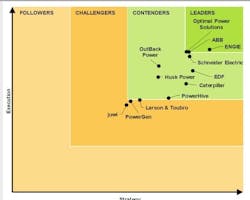Navigant: Remote Microgrids Have Huge Market Potential Globally
Remote microgrids are becoming the key source for delivering power to global regions that are either tough to traverse or where the main grid is not reliable. And some companies are finding this to be an attractive business model, not only because they can initially limit their capital outlays but also because they can eventually scale up their projects.
In 2018, the global market for remote microgrids totaled $3 billion. By 2027, it is expected to be $10.2 billion, says Navigant.
That’s according to the Navigant Research Leaderboard, which bases its examination on how much revenue within the “value chain” companies can capture — from origination to project development. Some vendors are more focused on integration and controls and others zero-in on engineering, procurement and construction. In other words, some businesses might score well in strategy but not that well in execution.
Which companies rank?
The top three “leaders” are Optimal Power Solutions, ABB and Engie. Then in the next tier, called “contenders,” there is Schneider Electric, EDF, OutBack Power, Husk Power, Caterpillar and PowerHive. And in the third layer, called “challengers,” there is Larson & Toubro, PowerGen and juwi.
For purposes of this study, “Microgrids are the only source of power in most cases,” says Peter Asmus, a research director for Navigant Research who is based in the US. “In some cases, they are connected to a weak grid, or one where the grid may be intermittent, like in India, which might be available four hours a day. They are typically located in foreign countries, and they have to work 24-7 in island mode. In this country, remote microgrids are prevalent in Alaska and the Arctic Circle.”
In 2018, the global market for remote microgrids totaled $3 billion. By 2027, it is expected to be $10.2 billion, says Navigant.
In Africa and Latin America, most microgrids are remote, although some are serving a specific business such as mining.
The energy access grids might be considered nanogrids, says Asmus, because of their size and scale — and the fact that they just serve a single entity. That is, they are the basic starting point to provide electricity but they can incrementally grow into more formal microgrids, connecting more and more homes and businesses.
Courtesy of Navigant Research
“Most of those profiled focus on remote microgrids,” says Asmus. But Schneider has historically been investing interconnected microgrids that both feed power back to the utility or that take electricity from it. It is now branching out and into remote microgrids.
Join us at Microgrid 2019, May 14-16 in San Diego to hear Peter Asmus discuss more of his research on both grid-connected and remote microgrids.
About the Author

